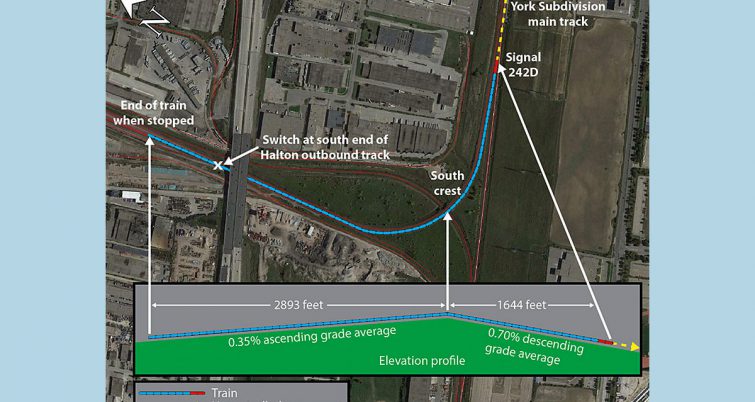Uncontrolled train movement prompts TSB to call for updated employee qualification standards
Written by Mischa Wanek-Libman, editor
An incident involving a train rolling uncontrolled for three miles has prompted the Transportation Safety Board of Canada to recommend an update to employee qualification standards.
The recommendation calls for Transport Canada to update the Railway Employee Qualification Standards Regulations to address what TSB calls existing gaps related to training, qualification and re-qualification standards, and regulatory oversight for employees in safety-critical positions.
The incident that led to the recommendation occurred in June 2016 at MacMillan Yard located in Vaughan, Ontario. A two-member crew was performing switching operations using a remote control locomotive system on a train consisting of 74 cars and two locomotives. The crew received permission to move the cut of cars south along a slightly ascending grade toward the edge of MacMillan Yard and then downhill onto the main track of the York Subdivision.
When the crew attempted to stop and reverse the cars back into the yard, the cars continued to move and rolled uncontrolled for about three miles, reaching nearly 30 mph before an ascending grade brought them to a stop. TSB credits the foreman’s quick emergency call to the rail traffic controller asking for assistance to protect the uncontrolled movement for minimizing the risk of collision and of a more serious outcome.
“The investigation found that the crew had not charged air brakes on any of the freight cars, which left only the independent brakes on the two locomotives to control the movement,” said TSB. “The crew members were qualified train conductors, but did not have sufficient operational experience to safely perform the tasks in this section of the yard. They had requested and received advance job briefings during which they reviewed operational requirements. However the briefings, job aid and procedures did not provide them with sufficient guidance. The crew was aware of the assignment’s length and weight, but did not fully understand how these factors affected train handling on a descending slope using only the locomotives’ independent brakes. As conductors, they had received little training in locomotive operation and train handling, as this was not required under existing regulations.”
Faye Ackermans, member of the board, said, “Since the Railway Employee Qualification Standards Regulations came into force in 1987, the rail industry has changed tremendously and the technology has evolved, but qualification standards and training requirements have not. Consequently, railway employees in safety-critical positions may not be sufficiently trained or experienced to perform their duties safely.”
TSB noted that the number of occurrences involving uncontrolled movements in Canada has increased by about 10 percent in the past five years, compared to the 10-year average.
Following the incident, Canadian National conducted a risk assessment that included a review of topography and air brake use in all its switching yards in Canada. Based on the review, CN implemented new minimum braking requirements for each yard including how many cars require charged air brakes prior to accessing main track.





